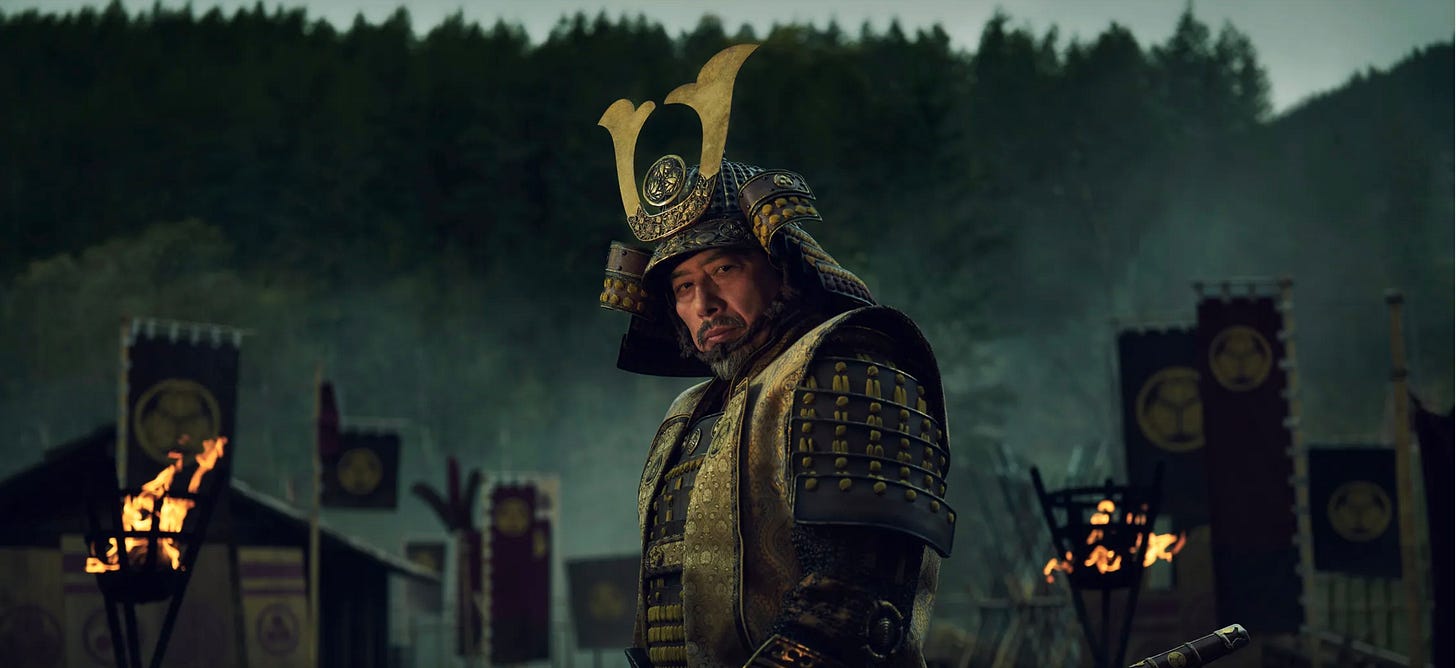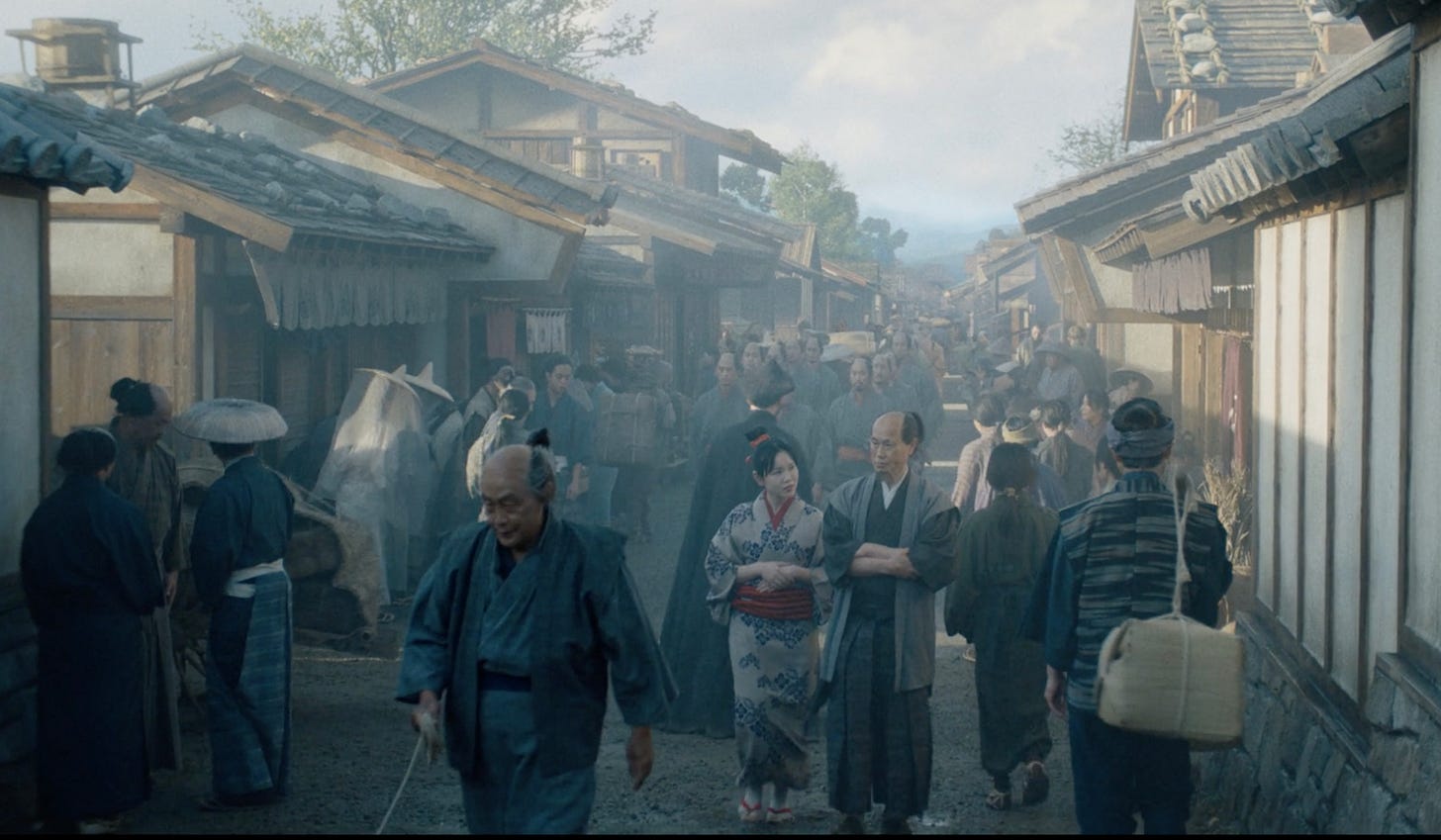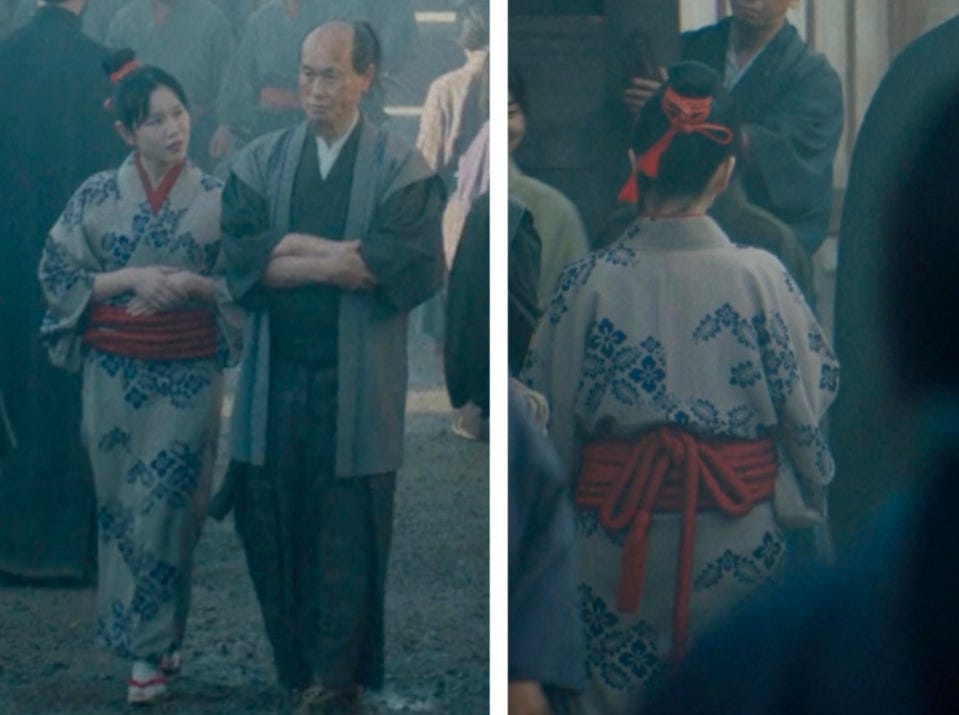Jidaigeki: Made in USA
A spoiler-free look at Shogun's cultural details, hiding in plain sight
When I first heard word that Americans were working on a new production of Shōgun, my expectations were brutally low. The reason being, Hollywood doesn’t have a great track record in portraying my people or culture. I honestly expected viewers would be presented with another strange pastiche of cliches of the sort I’d seen in so many foreign films, inevitably framing Japan as exotic and alien and fantastic. (Japanese call this Americanized approach the “Fujiyama-Geisha” view of our country.)
The 2003 film The Last Samurai was a big step forward in terms of cultural sensitivity, but it still felt “off” to native viewers in many subtle ways – “as though the producers didn’t quite understand the nuances between China and Japan,” as Hiroyuki Sanada, who co-starred in that film, put it. Sanada, of course, went on to play both the lead role and co-producer of Shōgun. Even still, when he spoke of how much effort he spent helping make the new miniseries feel “natural to native Japanese eyes,” I didn’t know how seriously to take it.
But the 2024 remake of Shōgun blew me away – and I say that not only as a “native Japanese,” but one who’s a licensed kimono fitter and a student of history. I’ve actually written about this very same arc of history myself, in the book Ninja Attack! True Tales of Samurai, Assassins, and Outlaws. I know firsthand how difficult it is to contextualize all of the historical places and players and dramas for foreign audiences, how tough it is to convey rich cultural details in ways that will be understood by those who didn’t learn about the Sengoku era in their childhoods, as every Japanese did in school.
Shōgun is many things, but at its heart it is what we Japanese call a jidaigeki – a period drama. Jidaigeki were one of the most popular forms of entertainment in the postwar Showa era. There were big-budget jidaigeki films, such as Akira Kurosawa’s Yojimbo and Seven Samurai and Rashomon, and primetime jidaigeki television dramas.
At the genre’s peak in 1973, there were more than thirty jidaigeki airing every week on Japanese television. The genre had no shortage of fans outside Japan; Kurosawa’s films were big hits abroad. His movie The Hidden Fortress famously inspired elements of Star Wars, and director George Lucas, according to legend, named the Jedi as a tip of the light-saber to jidaigeki.
But times and tastes change. Just as Westerns once fell out of favor in Hollywood, so did jidaigeki in Japan. Younger viewers in particular came to find them old-fashioned, not only because of the settings but because they associated them with “old-fashioned” people, namely their parents and grandparents. So ratings declined. But it costs a lot of money to make a decent period drama. Everything onscreen – the vintage-seeming buildings and settings, the props, the costumes and even the wigs – needs to be made from scratch. And the actors had a hard job, too. They needed to perfect archaic mannerisms, forms of speech, and of course, theatrical combat techniques. By the end of the Eighties, corporate sponsors came to see jidaigeki as a losing game for promoting their products, and stopped footing the bills for the productions. In the 1990s, the genre was pretty much on life support. I can’t think of a single jidaigeki from that time.
So 2003’s The Last Samurai was the first period drama I saw in many years, but I didn’t think of it as a jidaigeki. I don’t think many Japanese did. If you asked, I suspect they’d have answered, without condescension, that it was in the genre of Tom Cruise. But Tom’s (can I call you Tom?) appearance in the film wasn’t the issue. What makes a jidaigeki is attention to setting and fine detail – detail that is really difficult to achieve even in Japan. All those sets, costumes, wigs, weapons, and accouterments require a lot of money to make – and a lot of historical /cultural knowledge to use properly.
That is the context for my apprehensions about the 2024 Shōgun. And why I was so shocked at what I was seeing on screen, virtually from the first moments of the first episode. This wasn’t Fujiyama-Geisha-ville. For a series created by Americans, based on a British author’s book, and filmed in Vancouver, it felt incredibly, almost overwhelmingly, authentic. So much so that I think many non-Japanese viewers may have missed the subtleties. In fact, I think a lot of Japanese viewers may have missed them, too. So I wanted to talk about a few here – not to scold you, but to give you the context you need to appreciate the show even more the next time you watch.
The last time I wrote about Shōgun, I explained a few subtle mannerisms that were easy to miss if you weren’t intimately familiar with Japanese culture. This time, I’d like to focus on one of my favorite subjects: the kimono. People wore kimono very differently back then. Here’s a scene with a lot of interesting examples.
This moment from episode 2 follows a Catholic missionary walking down a street. It only lasts a few seconds. But if you watch it with the right eyes, you can learn many things. First you see an old man walking a dog, and you can tell he lives very close by. You see a man and his daughter, and you can tell he is a wealthy merchant, and she seems keen on new fashions. You see samurai conversing, and know two are local, wth one visiting from far away. You see other women and know they are the wives or daughters of other samurai. You see others and know they are a local merchant, a traveling salesman, magistrates, or average townspeople.
How do I know who these people are, where they came from, even their levels of wealth?
Because of their kimono.
For instance, that old man walking the dog, front and center? He seems to be dressed in asa, hemp, which is the equivalent of casual, comfortable roomwear back then. He must live nearby. Now look at the group of samurai at left. One is wearing a sedge hat, the mark of a traveler. The other two are not, marking them as locals. Just over their shoulders can be seen a pair of women in diaphanous veils, streetwear for the nobility. And there are two merchants visible, both carrying wares of some kind. One, at far right, casually dangles a bag over his shoulder: he’s a local, because he isn’t wearing a hat. Meanwhile, the other is visible over the left shoulder of the man walking the dog. He is wearing a hat, and carries a sturdy backpack – the marks of a traveling salesman.
One of my favorite moments in this scene is this: a wealthy merchant accompanying his fashionable daughter. Let’s take a look at that one in more detail.
I know he is a merchant rather than samurai, for he is dressed in a fine kimono, yet carries no swords. And he must be doing well, for this is an opulent silk kimono. Now look at her bright red belt. It is called a Nagoya obi – not for the city, but rather written 名護屋帯. We don’t generally tie obi this way anymore; we use wide sashes, not looped cords. But Nagoya obi were expensive and fashionable at this time in history. Her hair also speaks to her interest in trends. This is a karawa-mage, which was a new hairstyle of the era. Traditionally, women grew out their hair and left it as-is – that was how Mariko wore her hair in the series. But city women began tying their hair up in karawa-mage to be hip. This style is in fact the predecessor of the Shimada hairstyle worn by modern-day geisha and maiko.
This is just one example of the level of detail the staff brought to the production of the 2024 Shōgun miniseries. And it’s part of the reason the series swept the Emmys last month. But perhaps the thing I love most about the series is how it bridges cultures, bringing the best of Hollywood AND Japanese knowhow to bear in making something totally new. As Sanada himself put it, “when people work together, we can make miracles…We can create a better future together.” I think so, too!
It sounds like the series has been green-lit for a second and potentially even a third season, and I’m looking forward to those. But in the meantime, I’d like to keep exploring the details of the first. Next time, I’m going to focus on the kimono worn by the female actors. And then in a subsequent essay, if there’s interest, I’d like to talk about the wide variation in the kimono worn by men.





Amazing breakdown as a Kimono noob looking for the future installments 🙌
Thanks for this excellent review and the detailed points. It is good to see the many things that Shōgun got right.
Did you read Azby Brown's short Facebook post about the issues with traditional Japanese architecture in the series? In his words:
"Shogun was entertaining and deserves its awards. But its much-touted historical accuracy doesn't include its architecture, which has glaring and easily-avoided 'fakeness.' I did an informal survey of colleagues who are experts in Japanese architectural history, and everyone agrees these mistakes are laughably bizarre. All of it could have been spotted at the design sketch stage. They really need better experts!"
His post features photos with notes of errors.
Brown is the author of "The Genius of Japanese Carpentry: Secrets of an Ancient Woodworking Craft" and other books about traditional Japanese architecture.
https://www.facebook.com/azby.brown/posts/pfbid06czTWButSZTnk1U7cyBMAqbUgUCaKHZdhRXhZuqC2igA79bDQTeSV2ALqUQ4drMzl